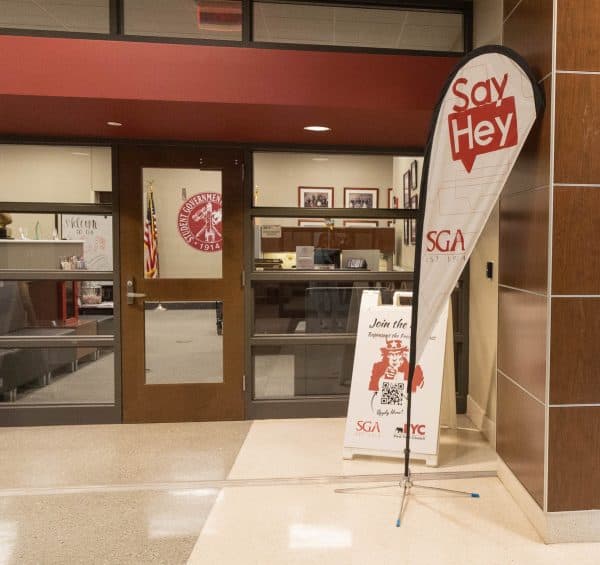College campuses breed drinking culture
April 23, 2018
Editor’s note: Charlie’s name has been changed for privacy reasons.
Before a date party freshman year, Charlie ate an early dinner, got ready, then started drinking before heading to a pregame.
“I thought I had two drinks, but the last thing I remember is sitting at the table drinking and then I blacked out,” Charlie said.
She woke up the next morning with no idea of where she’d been. A vague memory of being at an off-campus apartment with a dog floated across her mind, but she eventually found out that she ended the night at Presidential Village II.
With a laugh and a shrug, Charlie described her experience as one of those college stories she plans to tell her kids.
“We all died that night, but I think it was fun,” she said. “In the pictures it looked fun.”
According to the Centers for Disease Control and Prevention (CDC) underage drinkers account for 11 percent of all alcohol consumption in the U.S., and underage people tend to binge drink. Binge drinking, defined as drinking more than three standard drinks in one night for a woman or more than four for a man, is the third leading cause of preventable death in the U.S.
When students enroll at the University they have to take a course called AlcoholEdu that describes safe drinking practices and gives definitions for things like standard drinks. Dr. Ed Geno, an assistant professor of family medicine who also works with Druid City Hospital (DCH), said while this information is important, it’s not enough.
“Some of the things about drinking in universities across the country, is they might make their students watch a ‘drink safely’ instead of saying, ‘don’t drink,’” he said. “That’s not what the culture is. In reality that’s where some of these problems and some of these deaths come from.”
The CDC estimates 88,000 people die annually from alcohol-related effects ranging from accidents like falling to physical reactions to alcohol toxicity.
“If [that death toll] was associated with guns, you’d have people marching all over the place,” Geno said.
Student access to alcohol is different from gun access as well. Charlie doesn’t have a fake, but said she can get alcohol by asking a friend who is over 21. While the Alcoholic Beverage Control Board (ABC) does have its own enforcement department, Dean Argo, the government relations manager, said they only have civil inspectors who check licensed establishments for proper signage and other visual compliance methods. The State of Alabama Law Enforcement Agency (ALEA) is the one responsible for handling criminal enforcement.
“If we visibly see someone under the age of 21 that’s on the premises and they’re not supposed to be there, then we will immediately go back outside and notify ALEA,” Argo said.
Now in her second year of college, Charlie is no longer worried about getting caught drinking even though she’s still underage.
“I just forget,” Charlie said. “I think because everyone drinks, and like UAPD doesn’t really care about underage drinking that much and they just want people to be safe, so I never worry about getting in trouble.”
In a statement from UAPD, Chief John Hooks said despite the laws, police enforcement shouldn’t be the main solution to students’ drinking.
“The law prohibits underage drinking; however, making arrests shouldn’t be the primary or first response,” Hooks said. “A more holistic approach includes health, legal and safety education and training supplemented by alternate activities for students on and off campus that don’t involve alcohol.”
Geno agrees and said self-enforcement has to come in to play at some point. Bars wouldn’t be open if they didn’t have customers. However, he said the entire problem comes down to a culture of drinking, no matter if it’s people over or underage.
“I wouldn’t blame the alcohol boards or the police necessarily, or I wouldn’t necessarily just blame the person who just drank,” he said. “There’s a whole culture.”
Geno said the ‘drink responsibly’ campaigns from universities aren’t the only institutional issue. Driving around Tuscaloosa, people can see billboards advertising Bud Light for game days. Geno said the government and other regulatory agencies do nothing to stop advertising alcohol despite its toxicity.
“These organizations are silent to the promotion of alcohol in this place where your friends, your sisters, your brothers could be harmed,” Geno said. “And thousands are.”
Terri Snider, a registered nurse and director of the emergency department at DCH, said lack of experience with alcohol commonly leads to injury here.
“A lot of times what we see is people that maybe are away from their home setting for the first time and they just don’t really know their limits, and so they just kind of go over and beyond,” she said.
Snider said one of the big times they see people exceeding their alcohol limits is during the fall and football season, and the hospital isn’t the only one seeing an uptick in activity from alcohol usage. UAPD deals with more public intoxication and other disruptive behavior like harassment on popular football weekends.
When drinking, Charlie doesn’t use her AlcoholEdu training much, but she said her experience drinking in high school prepared her.
“I think I learned my limit in high school,” she said. “I mean, obviously, I still drink over what I should, but when I came here last year I knew how to drink. Like some of my friends were freshman that had never drank and when they first started drinking it was like they would just be throwing up every night because they drank so much.”
Geno said while knowing your limits is important, some people don’t realize just how low those limits are, and for someone underage, that limit should stay within the guidelines of the law.
“For some people, one is too much, for other people, one is probably going to be ok, but if somebody is underage, it’s not ok,” he said. “If somebody is operating heavy machinery, one is not ok. If somebody is pregnant one is not ok. If someone has varying medical problems that you can talk to your doc about, it’s not ok, not even one. Not even one drink.”
Charlie said she’s a “bad influence” on her friends when it comes to drinking, but peer pressure isn’t the only reason she and her friends drink.
“We have to pregame before we go to the pregame so it’s not awkward,” she said.
Pregaming contributes to risky drinking behaviors, but risky drinking doesn’t mean someone has an alcohol dependence. Geno said developing a dependence takes time, but it varies from person to person based on genes, medical circumstances or willpower. One of the more common signs of developing a dependence is a higher tolerance of alcohol in general. Geno likened it to a truck that’s used to pushing against a certain size load.
“They gain tolerance,” he said. “That’s because their brain is starting to make accommodation for the sedation of the alcohol. Now they have to put that load on the truck otherwise, when you have no load, you press the gas and you’re full-on to a dangerous level.”
The “dangerous” level of excitement manifests itself as tremors, seizures and unusual amounts of sweat. These symptoms are also known as withdrawal.
Geno said the damage from either alcohol dependency or risky drinking is comparable.
“[Risky drinkers] can injure themselves, but it’s going to be in a different way, because one is a constant beating over years and one is just a pummeling on weekends,” Geno said. “It still can change your brain. It still can change your body. It can still make you flunk out of school and not fulfill your obligations.”
Geno said there has to be an overhaul of drinking culture in order to see a reduction in the negative effects from alcohol.
“It has to be a different kind of way of life,” he said. “That’s not the way of life that you see here. This kind of way of life is a dangerous kind of thing. This is something that will harm you.”
However, Geno said he doesn’t see expect to see this cultural change anytime soon.
“I don’t want to see another baby with fetal alcohol syndrome, but I will,” he said. “I don’t want to see another person maimed by an accident, but I will.”
Charlie said she feels uncertain about a shift in just her own drinking habits. She doesn’t know if after she turns 21 she’ll start drinking less or more safely.
“I have to think at some point it will change,” she said. “I don’t know, maybe not. Maybe just my friends and I are crazy.”
Both Snider and Geno agree that if someone is worried they’re tipping into a danger zone with drinking, whether it’s a dependency or a momentary medical emergency, they should go to a doctor, no matter if they’re underage or not.
“If you have a problem, your primary care physician is someone you should be able to talk to, and there’s probably less social stigma for you to come and talk to your doctor first, and then to be able to make a plan, because there are ways that they can help you,” Geno said.
Besides the University Medical Center and DCH, the University has the Collegiate Recovery and Intervention Services on campus for students who want a community to rely on while facing abstinence-based recovery.











